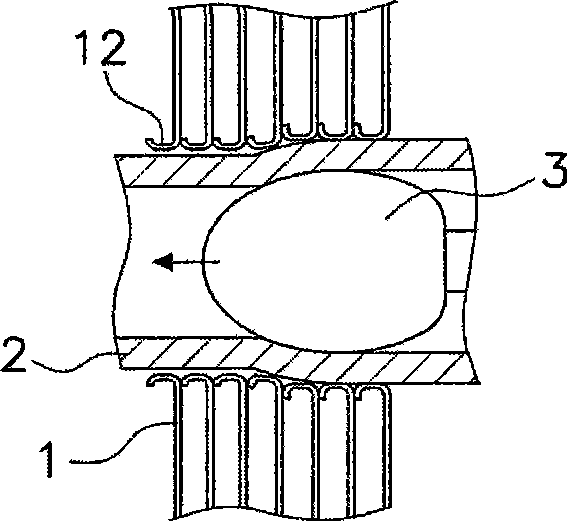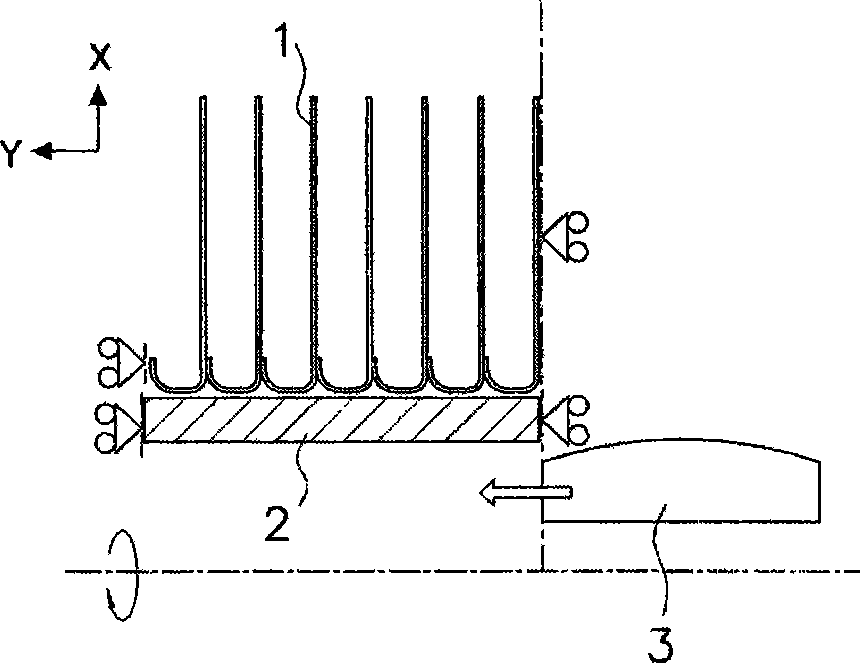Heat exchanger fin and fin tube type heat exchanger
A technology of heat exchanger and finned tube, which is applied in the field of heat exchanger and its fins, can solve the problems that the thermal conductivity cannot reach the calculated value, and the undisclosed method of determining the three circular arcs, etc., so as to improve the heat transfer efficiency Effect
- Summary
- Abstract
- Description
- Claims
- Application Information
AI Technical Summary
Problems solved by technology
Method used
Image
Examples
Embodiment 1
[0058] like Figure 5 As shown in (a), in Embodiment 1, a single control point is used as the optimization variable of the cross-sectional shape of the fin collar. And the section shape of the fin collar is a spline curve passing through three points. That is, take the coordinate value X1 of the middle point of the middle part of the collar 122 in the vertical direction as the control point of the spline curve, and construct the middle point X1 of the middle part of the collar 122 and the first end point of the middle part of the collar 122. A spline curve of three points including X2 and the second end point X3 of the middle portion 122 of the collar. As a result, the Figure 5 (b) The optimized shape shown. Table 1 shows changes in shape before and after optimization in Example 1.
[0059] Table 1
[0060]
Embodiment 2
[0062] like Image 6 As shown in (a), in Example 2, a single control point is used as the optimization variable of the cross-sectional shape of the fin collar. And the section shape of the fin collar is a spline curve passing through five points. That is, take the coordinate value X1 of the middle point of the middle part of the collar 122 in the vertical direction as the control point of the spline curve, and construct the middle point X1 of the middle part of the collar 122 and the first end point of the middle part of the collar 122. A spline curve of five points including X2, the second end point X3 of the collar middle portion 122, the predetermined point C1 of the collar bending end portion 123, and the predetermined point C2 of the collar root portion 121. As a result, the Image 6 (b) The optimized shape shown. Table 2 shows changes in shape before and after optimization in Example 2.
[0063] Table 2
[0064]
Embodiment 3
[0066] like Figure 7 As shown in (a), in Embodiment 3, three control points are used as variables for optimizing the cross-sectional shape of the fin collar. And the section shape of the fin collar is a spline curve passing through five points. That is, with the coordinate value X1 of the middle point of the collar middle part 122 in the vertical direction, the coordinate value X2 of the first end point of the collar middle part 122 in the vertical direction, and the second end point of the collar middle part 122 in the vertical direction The coordinate value X3 in the vertical direction is used as the three control points of the spline curve, and the relationship between X2 and X3 is set as: X2=X3=(C1-X1)×N+X1, 0 Figure 7 (b) The optimized shape shown. Table 3 shows changes in shape before and after optimization in Example 3.
[0067] table 3
[0068]
PUM
 Login to View More
Login to View More Abstract
Description
Claims
Application Information
 Login to View More
Login to View More - R&D
- Intellectual Property
- Life Sciences
- Materials
- Tech Scout
- Unparalleled Data Quality
- Higher Quality Content
- 60% Fewer Hallucinations
Browse by: Latest US Patents, China's latest patents, Technical Efficacy Thesaurus, Application Domain, Technology Topic, Popular Technical Reports.
© 2025 PatSnap. All rights reserved.Legal|Privacy policy|Modern Slavery Act Transparency Statement|Sitemap|About US| Contact US: help@patsnap.com



